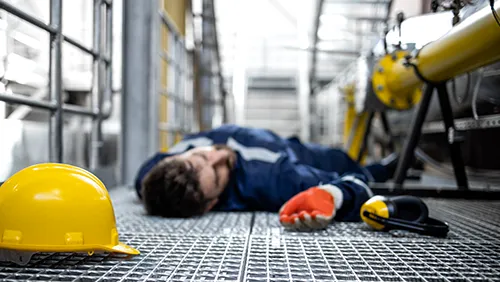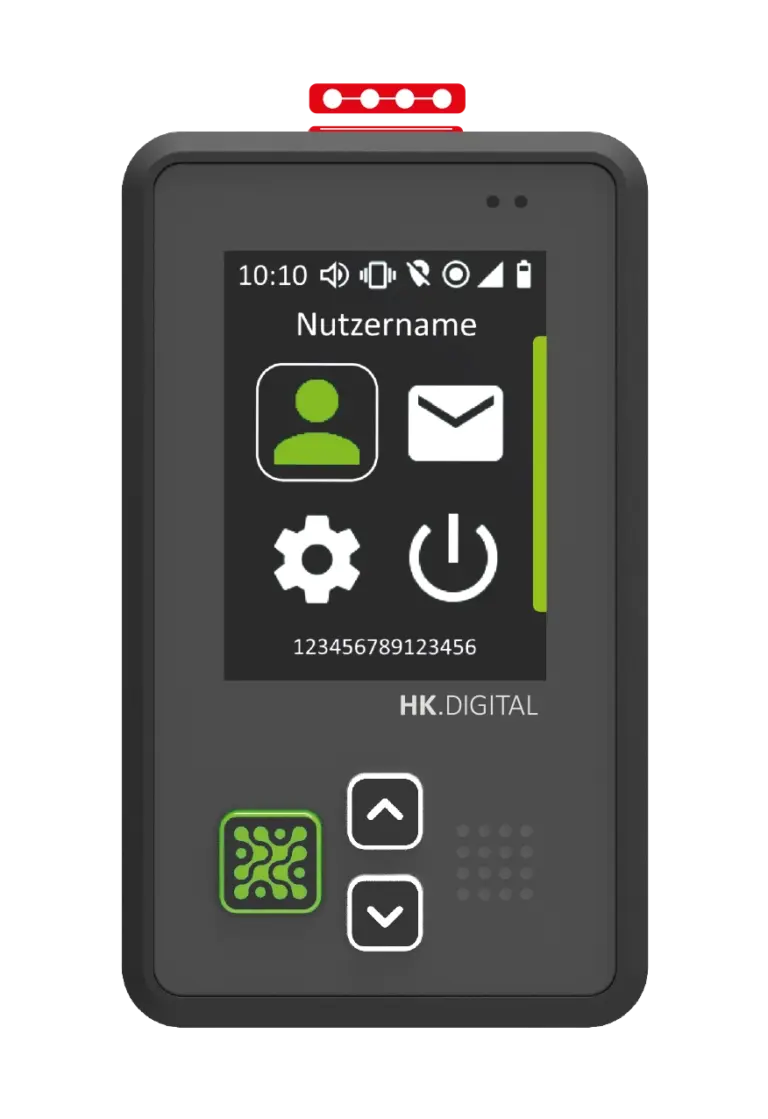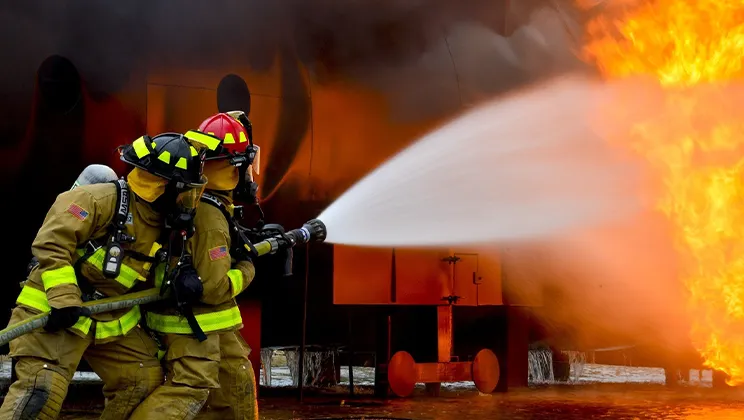Working alone:
FREDDY saves lives
- Excellent network coverage even
with poor signal strength
and in shielded rooms - Emergency call function with location transmission
- Life-saving dead man’s function
- Ready for immediate use
FREDDY – effective emergency call solutions for working alone
According to the law, lone working always occurs when a person carries out their work alone and out of the call and sight of other people.
The duration of lone working is irrelevant.

Industry | Trade |
Warehouse | Archiving
High degree of automation: Individual employees in production facilities, warehouses and logistics. Often associated with severely restricted hearing and visibility.

Building construction and civil engineering |
Gardening and landscaping
Increased or critical hazard: Driving and unloading bulk goods, working on large construction sites out of call and sight range, etc.

Agriculture and forestry
Increased or critical risk: Daily handling of pesticides and fertilizers, working in grain silos, operating large machines and in extreme temperatures. Frequently working alone outside of call and sight distance.

Security service | Building cleaning
Frequently work at night or at weekends, often out of call and sight range. Increased risks depending on the area of application.
FREDDY – Personal emergency signal system (PNA)
The task of a personal emergency signaling system (PNA): To immediately summon help for people in distress when working alone – by triggering and transmitting personal alarms that are dependent on and independent of the person’s will. The personal alarm is transmitted wirelessly via mobile radio to the receiving device.
Emergency call
Will-dependent alarm via
Easily accessible red emergency signal button
incl. pre-alarm ≤ 60 seconds
Dead man’s function
Willful rest alarm
incl. transmission of location (GPS)
≤ 90 seconds
Pre-alarm
Before triggering the independent alarm
≤ 45 seconds
Technical alarm
Continuous monitoring of
technical availability
≤ 30 minutes


Very high redundancy
Maximum accessibility thanks to
mobile technologies LTE CAT M1 ,
roaming SIM, dual SIM
High-performance battery
Comfortable battery life
of approx. 48 hours
Resistant
Robust in accordance with IP54, temperature
range: -20° C to 60° C
Accessories
Including shirt clip or
belt clip (optional)
Emergency call
Will-dependent alarm via
Easily accessible red emergency signal button
incl. pre-alarm ≤ 60 seconds
Dead man’s function
Willful rest alarm
incl. transmission of location (GPS)
≤ 90 seconds
Pre-alarm
Before triggering the independent alarm
≤ 45 seconds
Technical alarm
Continuous monitoring of
technical availability
≤ 30 minutes
Very high redundancy
Maximum accessibility thanks to
mobile technologies LTE CAT M1 ,
roaming SIM, dual SIM
High-performance battery
Comfortable battery life
of approx. 48 hours
Resistant
Robust in accordance with IP54, temperature
range: -20° C to 60° C
Accessories
including shirt clip or
belt clip (optional)
Risk analysis for lone working
According to the Occupational Health and Safety Act, the measures to be implemented by companies are based on a required and prescribed risk analysis.
The hazard risk is made up of: 1. the hazard level, 2. the probability of an emergency and 3. the duration until first aid is provided.
RISK = (hazard figure + assessment figure) x emergency probability figure
1. Hazard Levels – Determination of Hazard Rating
Low

Hazard factors that can cause minor injuries or minor acute health impairments to the person working alone. The person remains capable of action
Hazard Rating (HR) 1-3
Elevated

Hazard factors that can cause significant injuries or significant acute health impairments to the person working alone. In an emergency, the person no longer remains capable of action
Hazard Rating (HR) 4-6
Critical

Hazard factors that can cause particularly severe injuries or particularly severe acute health impairments to the person working alone. In an emergency, the person no longer remains capable of action
Hazard Rating (HR) 7-10
2. Probability of Emergency – Determination of Emergency Probability Rating
Low

No emergencies are generally expected, an emergency has hardly occurred or is conceivable so far
Emergency Probability Rating (EP) 1-3
Moderate

Experience shows that emergencies are possible. Under similar working conditions, emergencies have occasionally occurred
Emergency Probability Rating (EP) 4-6
Elevated

Emergencies can be expected even under normal circumstances. Under similar working conditions, emergencies have repeatedly occurred.
Emergency Probability Rating (EP) 7-10
3. Assessment of Time Until Emergency Response Begins at Individual Workplace – Determination of Assessment Rating
Short

Less than 5 minutes
Assessment Rating (AR) 0
Medium

5 – 10 minutes
Assessment Rating (AR) 1
Long

10 – 15 minutes
Assessment Rating (AR) 2
Your Current Risk Assessment (R-Value):
The maximum value of 30 represents an acceptable risk. This means that working alone with constant monitoring is possible.
According to the Occupational Health and Safety Act and the German Social Accident Insurance (DGUV), the risk
must be minimized by additional technical and/or organizational measures if the risk rating exceeds 30.
Caution: If it is not possible to reduce the rating to a maximum of 30, working alone is not permitted!
Safety solutions for working alone
Signaling devices
Hazard levels
(Hazard risk in all cases < 30)
Low
Increased
Critical
Wired telephone
Stationary call system
Cordless phone
Cell phone
Radiotelephone
Time-controlled control calls
Dead man’s switch
Constant camera surveillance
Personal emergency signal system – PNA-11
Personal emergency signal system (in accordance with DGUV Rule 112-139)
Frequently asked questions – FAQ
Do you have a question about working alone or the legal requirements?
Then these tips and answers will certainly help you:
Lone working refers to activities that are carried out by one person alone, without the direct presence of colleagues or superiors. This means that they work out of sight and call range of others. This form of work involves particular risks, as there is no direct help on site in the event of accidents or health emergencies.
In Germany, there is no specific, uniform legal regulation for working alone. Instead, various occupational health and safety laws and regulations apply:
1 The aim of the Occupational Health and Safety Act is to ensure and continuously improve the safety and health protection of employees. Section 10 of the Occupational Health and Safety Act (ArbSchG) stipulates the following:
“The employer must take the measures required for first aid, firefighting and evacuation of employees in accordance with the type of workplace and activities as well as the number of employees. In doing so, he must take into account the presence of other persons. The employer must also ensure that the necessary connections to external agencies are established in the event of an emergency, particularly in the areas of first aid, emergency medical care, rescue and firefighting.”
2. § 10 of the Occupational Health and Safety Act (ArbSchG) is further specified by § 4 of the Workplace Ordinance (ArbStättV). Section 4 (5) of the ArbStättV states:
“When setting up and operating workplaces, the employer must provide first aid equipment and facilities and have them regularly checked for completeness and usability.”
The equipment and measures required for first aid are specified in the workplace regulation ASR A4.3. Section 5.1 paragraph 2 of ASR A4.3 states:
“Depending on the risk assessment, special signaling devices (e.g. emergency alarms) may be required. If it is not possible to provide stationary signaling devices, radio equipment, e.g. company radio systems, can also be used as signaling devices. In the case of lone working, personal emergency signal systems can be used – if necessary, also those that operate independently of the worker’s will.”
3 In addition, the German Social Accident Insurance (DGUV) has published several regulations on accident prevention.
DGUV Regulation 1:
DGUV Regulation 1 lays down basic obligations for employers. They are obliged to take measures to protect their employees from specific hazards (§§ 21 ff.). Employers must also ensure that the necessary equipment and materials are provided for first aid and rescue from dangerous situations. It is particularly important that they use reporting systems to ensure that the necessary help can be requested immediately if required and directed to the scene (§§ 24 ff.).
DGUV Rule 100-001:
The DGUV regulations are defined in more detail by the so-called DGUV rules.
DGUV Rule 100-001 describes hazardous work. Section 2.7.2 states:
“If hazardous work is carried out by a single person alone, the employer must provide suitable technical and organizational measures for personal protection in addition to the general protective measures.”
Working alone in this context means that a person performs work alone, out of call and sight of others. Technical measures also include suitable emergency signal systems for people.
DGUV Rule 112-139:
The details of personal emergency signal systems are set out in DGUV Rule 112-139. These systems are used to trigger and transmit volitional and non-volitional alarm signals in emergencies. They consist of personal emergency signal devices (PNG) and a personal emergency signal receiving center (PNEZ). Important: The DGUV accident prevention regulations do not stipulate that employees must be equipped with a dead man’s switch for all forms of lone working; this obligation only applies to hazardous work. A risk assessment must be carried out to determine whether the work is hazardous. The distinction is often not clear. It is therefore advisable for the employer to equip employees working alone with a personal emergency call device in order to be on the safe side with regard to first aid reporting equipment. Too much safety is always better than too little.
Lone working is common in many industries, especially where employees work in remote locations or in special work areas. Lone working is particularly common in industry, for example in maintenance or inspection work in large plants, in the skilled trades, in service and maintenance services and in the construction industry. Employees in healthcare, nursing and security services also often work alone, as well as in the transportation and logistics sector, where drivers and delivery staff are often unaccompanied. Due to the increased risks, many companies in these sectors rely on special safety solutions such as personal emergency signal systems to be able to support employees quickly in an emergency.
Dangerous lone working is when a person carries out work alone that entails an increased risk of accident or health hazards and no immediate help is available. This can occur in areas where heavy machinery, hazardous substances or working at great heights are involved. Work in remote locations is also considered dangerous lone working, as rescue in emergencies is often delayed. In such cases, employers are obliged to provide special protective measures, such as regular control calls or personal emergency signal systems, to ensure the safety of lone workers.
When working alone, there are several hazardous factors that increase the risk of accidents and health problems. The most common risks include accidents caused by machines or tools, tripping and falling hazards, health emergencies such as sudden illness and the risk of not receiving direct help in dangerous situations. In safety-relevant professions, the danger from aggressive people or environmental influences can also play a role. As there are no colleagues in the immediate vicinity when working alone, companies must implement suitable protective measures such as personal emergency signal systems and regular safety checks to ensure the safety of employees.
In Germany, employers are legally obliged to ensure the safety of their employees, even if they work alone. Employers have a special responsibility when organizing lone working.
The obligations of employers essentially comprise the following aspects:
– Risk assessment: The employer must carry out a comprehensive risk assessment to identify all possible risks to which a lone worker could be exposed.
– Risk minimization measures: Based on the risk assessment, the employer must take appropriate measures to minimize or completely eliminate the risks. This can include both technical and organizational measures.
– Technical equipment: In many cases, technical equipment is required to provide rapid assistance in an emergency. This includes, for example, personal emergency signal systems that automatically trigger an alarm in the event of an accident.
– Organizational measures: In addition to the technical equipment, organizational measures are also important, such as regular inspections, telephone contacts and employee training.
– Operating instructions: For hazardous activities involving lone working, employers must draw up detailed operating instructions in which the risks, the necessary protective measures and what to do in an emergency are described in detail.
– First aid: Employers must ensure that first aid can be provided quickly in the event of an emergency.
Yes, in Germany employers are legally obliged to carry out a risk assessment. This legal obligation arises from the Occupational Health and Safety Act. The purpose of a risk assessment is to identify all possible risks in the workplace that could endanger the health and safety of employees. This involves not only obvious hazards, but also less obvious risks that may only become apparent on closer inspection.
A risk assessment comprises a systematic examination of all work areas and activities. Both physical hazards (e.g. noise, heat, hazardous substances) and mental stress (e.g. stress, bullying) are taken into account.
Employers are fundamentally responsible for risk assessment. They can seek support from specialists, such as safety experts or company doctors.
In the event of an inspection by the supervisory authorities, employers can be subject to substantial fines. Employers are also liable in the event of damage.
Yes, in many cases the installation of an emergency call system is mandatory for people working alone in Germany. Whether such a system is mandatory depends largely on the type of activity and the associated risks. Work in isolated or remote areas, where rapid assistance in an emergency is not guaranteed, generally requires additional technical protection. The exact obligation to install an emergency call system is set out in various regulations, in particular DGUV Regulation 1 (see above) and the Workplace Ordinance. These regulations stipulate that employers must take all necessary measures to ensure the safety of their employees. This also includes the provision of suitable technical aids if the activity is associated with increased risks.
Yes, as a rule, special training or instruction is mandatory for employees who work alone. Whether such training is required depends on the specific activity and the associated risks. In principle, however, the higher the risk, the more comprehensive the training should be. Employers are responsible for ensuring that such training takes place.
The aim of training on working alone for employees is to prepare them for the particular challenges and hazards. The specific content varies depending on the industry, workplace and risk potential – but should typically cover the following topics:
1. definition and legal framework of lone working
2. Risk assessment and protective measures
3. Emergency preparedness and communication
4. Psychosocial aspects
5. Practical exercises and scenarios
6. Documentation and evidence
There are a number of technical aids available to make working alone safer. These are primarily used to quickly alert help in an emergency and thus ensure the safety of the person working alone. There are various technical aids that significantly reduce the risk for people working alone. The most important of these include personal emergency signal systems (PNA), which automatically or manually send a signal to a control center in an emergency so that help can be organized quickly. Other tools include mobile emergency call devices, GPS tracking to determine location and mobile apps that enable regular status reports or offer alarm functions. Camera systems and radios can also be useful to ensure contact with people working alone and to be able to react quickly in an emergency.
A personal emergency signal system (PNA) is a technical system that has been specially developed to ensure the safety of people working alone.
The system consists of portable devices that send an emergency signal automatically or manually in the event of an emergency, for example if an employee falls or becomes immobile. This signal is sent to a control center or a defined contact person in order to organize rapid assistance. A PNA is primarily used in high-risk work areas, such as in industry, construction, maintenance work or in the security sector, to ensure the protection of people working alone.
Employers can implement various organizational measures to increase the safety of people working alone. The first step is to carry out a comprehensive risk assessment to identify specific risks associated with working alone. On this basis, regular control calls or reporting intervals can be defined, during which employees working alone are in contact with the control center at fixed intervals. It is also advisable to provide clear emergency plans and training on the use of personal alarm systems (PNA) so that employees know exactly what to do in an emergency. Establishing communication times and regular safety briefings also make a decisive contribution to increasing occupational safety.
Yes, regular monitoring of lone working is necessary, especially if the activity is associated with increased risks. Occupational health and safety laws and guidelines recommend continuous monitoring or monitoring at fixed intervals in order to be able to react quickly in an emergency. This can be done via control calls, automatic reporting systems or technical aids such as personal emergency signal systems (PNA), which automatically trigger an alarm in the event of an emergency or lack of feedback. These measures ensure that help is available quickly in the event of an incident and that the safety risk for lone workers is minimized.
An emergency plan for lone workers should contain clear instructions and measures to be able to react quickly and effectively in critical situations. Important components include the contact information of the responsible persons or control centers, a precise description of the working environment and potential hazards as well as the possible use of personal emergency signaling systems (PNA) or other emergency call systems. The plan should also specify how often control calls or reporting intervals will take place and provide specific steps for first aid and emergency communication. The plan must be updated regularly and communicated to employees in training sessions so that everyone involved is optimally prepared in the event of an emergency.
Employers can obtain comprehensive information and support on the safe organization of lone working from various sources. The most important bodies include the employers’ liability insurance associations and the accident insurance funds, which offer practical recommendations and training. The Federal Institute for Occupational Safety and Health (BAuA ) also provides guidelines, studies and work aids to optimize occupational safety when working alone. As a specialist provider of safety solutions, we also offer advice and technical aids such as personal emergency signal systems (PNA) to specifically increase safety when working alone.
Employees are welcome to contact us if they have any questions about working alone. Important information on this topic can also be obtained from the employers’ liability insurance associations, accident insurance funds and the Federal Institute for Occupational Safety and Health (BAuA).
In Germany, employers are legally obliged to ensure the safety of their employees, even if they work alone. Employers have a special responsibility when organizing lone working.
The obligations of employers essentially comprise the following aspects:
– Risk assessment: The employer must carry out a comprehensive risk assessment to identify all possible risks to which a lone worker could be exposed.
– Risk minimization measures: Based on the risk assessment, the employer must take appropriate measures to minimize or completely eliminate the risks. This can include both technical and organizational measures.
– Technical equipment: In many cases, technical equipment is required to provide rapid assistance in an emergency. This includes, for example, personal emergency signal systems that automatically trigger an alarm in the event of an accident.
– Organizational measures: In addition to the technical equipment, organizational measures are also important, such as regular inspections, telephone contacts and employee training.
– Operating instructions: For hazardous activities involving lone working, employers must draw up detailed operating instructions in which the risks, the necessary protective measures and what to do in an emergency are described in detail.
– First aid: Employers must ensure that first aid can be provided quickly in the event of an emergency.
Yes, in Germany employers are legally obliged to carry out a risk assessment. This legal obligation arises from the Occupational Health and Safety Act. The purpose of a risk assessment is to identify all possible risks in the workplace that could endanger the health and safety of employees. This involves not only obvious hazards, but also less obvious risks that may only become apparent on closer inspection.
A risk assessment comprises a systematic examination of all work areas and activities. Both physical hazards (e.g. noise, heat, hazardous substances) and mental stress (e.g. stress, bullying) are taken into account.
Employers are fundamentally responsible for risk assessment. They can seek support from specialists, such as safety experts or company doctors.
In the event of an inspection by the supervisory authorities, employers can be subject to substantial fines. Employers are also liable in the event of damage.
Yes, in many cases the installation of an emergency call system is mandatory for people working alone in Germany. Whether such a system is mandatory depends largely on the type of activity and the associated risks. Work in isolated or remote areas, where rapid assistance in an emergency is not guaranteed, generally requires additional technical protection. The exact obligation to install an emergency call system is set out in various regulations, in particular DGUV Regulation 1 (see above) and the Workplace Ordinance. These regulations stipulate that employers must take all necessary measures to ensure the safety of their employees. This also includes the provision of suitable technical aids if the activity is associated with increased risks.
Yes, in many cases the installation of an emergency call system is mandatory for people working alone in Germany. Whether such a system is mandatory depends largely on the type of activity and the associated risks. Work in isolated or remote areas, where rapid assistance in an emergency is not guaranteed, generally requires additional technical protection. The exact obligation to install an emergency call system is set out in various regulations, in particular DGUV Regulation 1 (see above) and the Workplace Ordinance. These regulations stipulate that employers must take all necessary measures to ensure the safety of their employees. This also includes the provision of suitable technical aids if the activity is associated with increased risks.
Yes, as a rule, special training or instruction is mandatory for employees who work alone. Whether such training is required depends on the specific activity and the associated risks. In principle, however, the higher the risk, the more comprehensive the training should be. Employers are responsible for ensuring that such training takes place.
The aim of training on working alone for employees is to prepare them for the particular challenges and hazards. The specific content varies depending on the industry, workplace and risk potential – but should typically cover the following topics:
1. definition and legal framework of lone working
2. Risk assessment and protective measures
3. Emergency preparedness and communication
4. Psychosocial aspects
5. Practical exercises and scenarios
6. Documentation and evidence
There are a number of technical aids available to make working alone safer. These are primarily used to quickly alert help in an emergency and thus ensure the safety of the person working alone. There are various technical aids that significantly reduce the risk for people working alone. The most important of these include personal emergency signal systems (PNA), which automatically or manually send a signal to a control center in an emergency so that help can be organized quickly. Other tools include mobile emergency call devices, GPS tracking to determine location and mobile apps that enable regular status reports or offer alarm functions. Camera systems and radios can also be useful to ensure contact with people working alone and to be able to react quickly in an emergency.
A personal emergency signal system (PNA) is a technical system that has been specially developed to ensure the safety of people working alone.
The system consists of portable devices that send an emergency signal automatically or manually in the event of an emergency, for example if an employee falls or becomes immobile. This signal is sent to a control center or a defined contact person in order to organize rapid assistance. A PNA is primarily used in high-risk work areas, such as in industry, construction, maintenance work or in the security sector, to ensure the protection of people working alone.
Employers can implement various organizational measures to increase the safety of people working alone. The first step is to carry out a comprehensive risk assessment to identify specific risks associated with working alone. On this basis, regular control calls or reporting intervals can be defined, during which employees working alone are in contact with the control center at fixed intervals. It is also advisable to provide clear emergency plans and training on the use of personal alarm systems (PNA) so that employees know exactly what to do in an emergency. Establishing communication times and regular safety briefings also make a decisive contribution to increasing occupational safety.
Yes, regular monitoring of lone working is necessary, especially if the activity is associated with increased risks. Occupational health and safety laws and guidelines recommend continuous monitoring or monitoring at fixed intervals in order to be able to react quickly in an emergency. This can be done via control calls, automatic reporting systems or technical aids such as personal emergency signal systems (PNA), which automatically trigger an alarm in the event of an emergency or lack of feedback. These measures ensure that help is available quickly in the event of an incident and that the safety risk for lone workers is minimized.
An emergency plan for lone workers should contain clear instructions and measures to be able to react quickly and effectively in critical situations. Important components include the contact information of the responsible persons or control centers, a precise description of the working environment and potential hazards as well as the possible use of personal emergency signaling systems (PNA) or other emergency call systems. The plan should also specify how often control calls or reporting intervals will take place and provide specific steps for first aid and emergency communication. The plan must be updated regularly and communicated to employees in training sessions so that everyone involved is optimally prepared in the event of an emergency.
Employers can obtain comprehensive information and support on the safe organization of lone working from various sources. The most important bodies include the employers’ liability insurance associations and the accident insurance funds, which offer practical recommendations and training. The Federal Institute for Occupational Safety and Health (BAuA ) also provides guidelines, studies and work aids to optimize occupational safety when working alone. As a specialist provider of safety solutions, we also offer advice and technical aids such as personal emergency signal systems (PNA) to specifically increase safety when working alone.
Employees are welcome to contact us if they have any questions about working alone. Important information on this topic can also be obtained from the employers’ liability insurance associations, accident insurance funds and the Federal Institute for Occupational Safety and Health (BAuA).
Accessories
Power supply unit
The power supply unit is not included in the scope of delivery. However, you can use any commercially available power supply unit. We will be happy to offer you a suitable one for purchase on request.
Cables
A cable is not included in the scope of delivery. However, you can use any commercially available USB-C cable or have one supplied by us on request.
Belt clip
The pagers are supplied with a practical shirt clip. If you would also like a belt clip, we will be happy to supply you with this alternative.
Pager bag ALPHA
We offer the ALPHA pager bag in black with a high-quality Tenax fastener as a suitable addition.
Shirt clip
The pager is supplied with a shirt clip. If you require additional shirt clips, you can order them directly from us.

Pager F.R.E.D.
for BOS, fire departments and on-call services
For operations where every moment counts: Alert all required emergency personnel quickly and safely in a matter of seconds using a group call and specifying the required qualifications!